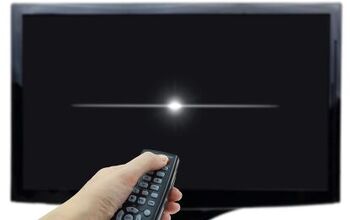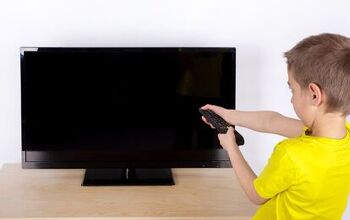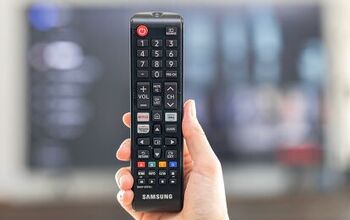Samsung TV Keeps Dimming? (Possible Causes & Fixes)

POV: You’re watching Ted Lasso, and you can’t help but notice the picture on your TV seems unusually dark. Why does your Samsung TV keep dimming?
Your Samsung TV Keeps Dimming due to the Ambient Light Detection function, a contrast imbalance, or maybe a weak signal. Turn up your brightness setting to 100% or turn the Energy Saving Mode off to help improve the dimness. If that doesn’t work, consult a Samsung TV technician to change out the backlights for $110.
In this article, we’ll dive into the reasons why your Samsung TV keeps dimming and how to solve each one.
Do You Need Appliance Repair Services?
Get free, zero-commitment quotes from pro contractors near you.

Why Does My Samsung TV Keep Dimming?
While a dim television can be quite annoying, it usually isn’t anything you need to worry too much about.
Here are a few common related causes:
- The Ambient Light Detection function
- Contrast imbalance
- Malfunctioning backlight
- Brightness setting is too low
- Energy Saving Mode is on
- Weak signal
All of these factors can have a cumulative effect on your TV’s brightness. Let’s get started exploring each one and discuss how to solve them!
The Ambient Light Detection Function
The most common reason your Samsung TV keeps dimming is due to a feature called the Ambient Light Detection function (or Eco Sensor in older models). This setting comes standard in any model made after 2016.
Samsung TVs have a brightness detection function that automatically adjusts the screen brightness to match the light in the room. This helps to avoid discomfort from the screen emitting too much light. It also means that if there is something wrong with the automatic setting, you may see your TV’s brightness periodically change without warning.
The first step is finding out if this is what’s happening. There are two ways to do that:
- Try to set your TV’s brightness level manually, and then watch for any sudden changes.
- Enable the ‘Ambient Light Detection’ option on your Samsung Smart TV menu and watch how it changes.
If your TV’s brightness drops down even although everything else is normal, you can chalk this issue up to your Ambient Light Detection setting.
To fix this, turn off the ‘Ambient Light Detection function on your Samsung Smart TV menu. In models made after 2016, can be done by going to Settings > General > Ambient Light Detection and toggling the setting to ‘Off.’ In old models, go to System > Eco Solution > Eco Sensor and select ‘Off.’
Once you disable this setting, you will need to manually adjust your television brightness to the appropriate level. Your new settings will be saved and won’t automatically change if there are any changes in room lighting conditions.
Note: On newer models or TVs released after Spring 2017, Ambient Light Detection is not automatically turned on but instead appears as an option.
Contrast Imbalance
Another common cause for this issue is due to differences in the contrast ratio.
The contrast ratio is the difference in luminosity between the brightest color (white) and the darkest black. The distance between these two colors will determine how vivid your picture looks.
Some Samsung TVs have a feature that automatically adjusts contrast ratios depending on ambient lighting, while others have a separate button on their remote control units.
How to Solve ThisAdjusting the contrast is relatively simple.
Follow these steps:
- Go to ‘Menu.’
- Hit ‘Enter’ on your remote.
- Select ‘Picture Mode’ and hit ‘Enter.’
- Choose ‘Contrast.’
- Use the up and down arrows to adjust accordingly.
Adjusting the contrast is a surefire way to improve not only the quality but also the brightness on your TV!
Malfunctioning Backlight
If you have a Samsung television, there is a good chance that it has an LED backlight.
LEDs are much more energy-efficient than traditional backlights because they can dim or brighten depending on the color settings. However, if your TV’s brightness levels fluctuate up and down randomly, the chances are that the backlight filter is malfunctioning.
How to Solve ThisPerform this fix at your own risk! However, we recommend calling in a technician.
The best solution to this problem is to replace the backlight, which costs around $110. Unplug the television from its power source for at least 24 hours to allow all parts inside to reset themselves.
To replace the backlight:
- Unscrew any screws on the back of your TV. Take off the exterior panel and move to the backlight side.
- Unplug all cables connected to the old light, remove it carefully, and disconnect.
- Reconnect the new LED light, screw it back together, and put everything else correctly.
What if You Don’t Have an LED Backlight?
If you do not have an LED backlight inside your television, don’t worry- this problem probably won’t affect you!
The only potential cause of this issue is that there may be dust or dirt accumulation inside your TV’s filters that are causing brightness levels to fluctuate up and down randomly. This will require opening up your Samsung TV set, so as advised, I would consult a trained Samsung TV technician.
Brightness Setting Is Too Low
The brightness setting on a Samsung TV is usually represented by a percentage.
This percentage will determine how visible the screen appears in relation to the outside light. If you notice that your TV keeps dimming and your brightness setting is less than 100%, then there is a good chance that this is the reason why.
How to Solve ThisThe solution is just as easy as adjusting the contrast levels.
Go to Settings > Brightness and use your remote arrows to turn the brightness up. This should solve it!
Energy Saving Mode Is On
The Energy Saving Mode in Samsung TV could be causing unwanted dimness.
This feature adjusts the brightness of your TV to limit energy consumption and reduce electricity bills. Energy Saving Mode is available in the Eco Solution menu of Samsung Smart TVs. There are five options of Energy Saving Mode: Off, Low, Medium, High, Picture Off.
How to Solve ThisYou have the option of turning your Energy Saving Mode to medium or low, but I would shut it off altogether. That way, you don’t have to worry about it contributing to any more problems.
To disable it, go to Menu > Settings > Eco Solution > Energy Saving Mode. Highlight this option and then select ‘Off.’
Weak Signal
If your Samsung TV is showing a low brightness on the screen, but you can’t locate any incorrect settings on your TV, then it’s time to check for any electric interference.
A weak signal can result from too many electronics running near your television or some type of construction nearby. Additionally, poor weather (if you’re using a satellite dish) can also weaken the signal.
How to Solve ThisIdentify the source of the problem.
If there are several electronic devices running near your television, try moving them further away from your set. Also, if you see construction or some sort of work being done nearby, consider contacting your HOA to see if any damage was done during their work.
Additionally, try adjusting your antenna to see if the reception improves. If it does not, try changing your antenna’s location or move it closer to an open window or door where no other electronics are running.
Lastly, reboot your Samsung TV. Sometimes all you need is a reset to get things working properly!
Video: If Nothing Else Works
Related Questions
Why does my Samsung TV turn off by itself?
Your Samsung TV is likely turning off without being prompted due to the ‘Sleep Timer’ setting.To adjust this, go to Settings > General > System Manager > Time > Sleep Timer and hit the ‘Off’ button. That should do the trick!Otherwise, if this still doesn’t remedy the issue, other external devices may be to blame. Reach out to a Samsung TV technician to have them diagnose the exact cause.
Why does my Samsung TV have no sound?
There are a few reasons your Samsung TV has no sound after you try turning up the volume directly on the TV or on your remote.If you have an external speaker, make sure the HDMI cord is secure. Next, turn your TV off and on because sometimes the sound lags. If neither of these work, it might be time to test the sound.On your Samsung TV, go to Menu > Support > Self Diagnosis > Sound Test. If you’re able to hear the jingle, you can attribute the issue to another part of the TV. Otherwise, if you can’t, contact support to further handle the sound issue.
My Samsung TV Smart remote is flashing red. What’s the fix?
Your Samsung TV Smart remote flashing red is indicative of dead batteries or the remote becoming unpaired.To repair your remote, follow these steps;Step 1: Press the ‘Home’ Button.Step2: Hold down the ‘Return’ and ‘Play/Pause’ buttons for 5 seconds.This will enter your TV and remote into pairing mode. If that doesn’t work, most Samsung TV remotes take AAA batteries, so swap those out!
Do You Need Appliance Repair Services?
Get free, zero-commitment quotes from pro contractors near you.

The Bottom Line
Your Samsung TV might be dimming because of a variety of reasons.
You can attempt to fix this by adjusting the brightness setting on your screen or turning off the Energy Saving Mode if it is in use. If these fixes don’t work for you, consult with a Samsung technician about replacing the backlight for a little over $100.
No matter the cause, with these quick troubleshooting techniques, your TV will be back to brightly streaming your favorite shows in no time!

Emily is a copywriter with over five years of experience in crafting content for the home renovation and remodeling industry. She loves house projects, whether it be painting a room or tweaking small design elements to transform a space. Her favorite aesthetic is french modern because of its clean lines and airy feeling! When not writing, Emily loves to travel and check out architectural details all over the world.
More by Emily Carr


















![12 Washing Machine Brands to Avoid [with Recall Data]](https://cdn-fastly.upgradedhome.com/media/2023/07/31/9075781/12-washing-machine-brands-to-avoid-with-recall-data.jpg?size=350x220)








